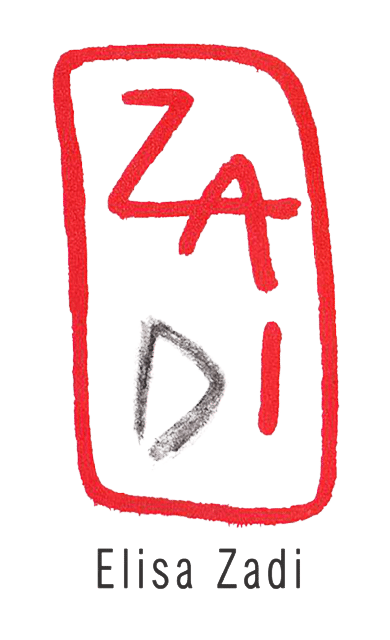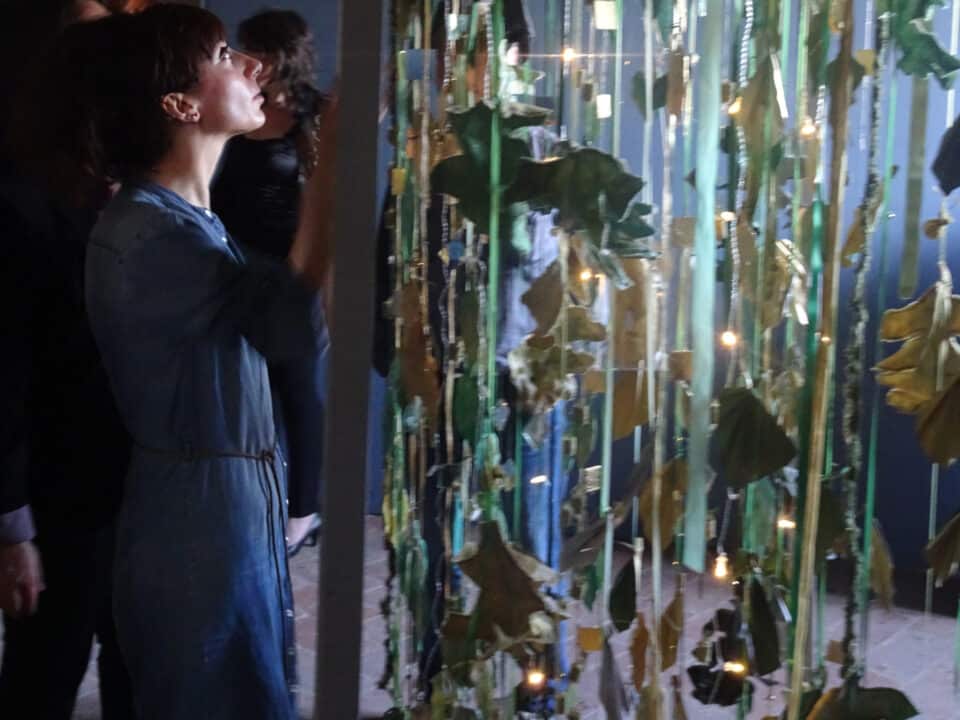Per Elisa Zadi la pittura è l’esperienza imprescindibile per sentire il preciso stato d’animo con cui affrontare quella tela ogni giorno diversa che si chiama esistere. Espressione di un’acuta volontà d’analisi, che sa addentrarsi nei meandri più profondi della sua psiche, il gesto del dipingere la rende forte, essendo come una preghiera, un rituale da compiersi ogni giorno, in silenzio, a contatto con la propria interiorità. Mentre dipinge non indaga se stessa come alterità temporanea, ma come universo da sondare, da scoprire nella propria verità. Il suo è un dipingere per toccarsi, per smuovere sentimenti che hanno nel corpo l’epicentro della loro venuta al mondo. Elisa guarda per essere di rimando vista da se stessa, nell’attesa spasmodica della manifestazione, dell’emersione sulla pelle e nei nervi di tutte quelle tumultuose o impercettibili vibrazioni, quelle oscillazioni spontanee che fanno del corpo la vera geografia dell’anima. Dipingere è il modo più alto di interrogarsi sul mondo, significa porsi inevitabilmente davanti a se stessa, implacabilmente, mossa dal bisogno profondo di guardarsi fuori per capirsi dentro, per scoprire cosa vuole, cosa desidera, cosa pensa, quale segreto si nasconde a quella confessione che di lì a poco sarà la pittura. Appassionata ed essenziale, audace e cruda, da sempre Elisa Zadi tende alla totale libertà nell’arte; una libertà che, come nella vita, consiste solo e soltanto nella ricerca della Verità. Tirare fuori dalla realtà la forma della Verità, ecco cosa cerca di fare nella pittura. Poiché Forma, Realtà e Verità sono indissolubilmente legate come Corpo, Psiche e Spirito, Elisa non prescinde dalla forma visibile, nella piena consapevolezza di questa ineluttabile indissolubilità. L’artista definisce il suo stile non senza una certa riflessione plastica-scultorea, attraverso un modus pittorico che, nel suo essere fortemente espressivo, tiene ben presente la plasticità della forma, e che intende il colore come materia con cui plasmare sulla tela i volti dei suoi personaggi, che si protendono verso l’osservatore emergendo dal “vuoto” concettuale dello spazio. Il respiro artistico di Elisa Zadi le permette di lasciare non finite alcune parti del dipinto, proprio perché, in un certo senso similmente a Michelangelo scultore, l’artista ritiene già “tirato fuori” il concetto che ha mosso la sua creazione, non preoccupandosi delle finiture essendo l’opera già conclusa in se stessa. Le figure vengono fatte emergere dal fondo della tela, affiorando da queste trame come se fossero in esse già contenute. È lì che Elisa percepisce l’immagine, è lì che la sente respirare: starà al suo gesto liberarla da quei fili intrecciati e portarla alla luce, in uno scavo tanto fisico quanto psicologico. Michelangelo sentiva la forma della scultura preesistere all’interno del blocco di marmo, e la liberava levando attorno ad essa quella materia superflua che non poteva né doveva più essere rimessa; per contro, Elisa Zadi pone sulla superficie pittorica quella materia cromatica che non può più essere tolta né tantomeno modificata. La sua pittura procede e si sviluppa come una scrittura che non conosce ripensamenti o aggiustamenti: l’artista non fa altro che disporre sulla tela toni di colore affiancati, senza mescolarli, senza mascherarli, senza sporcarli, nell’intento di restituirci una purezza della creazione nella sua più autentica originarietà. Nel polittico “Verso Michelangelo” Elisa rappresenta una massa di persone che si accalcano in una fila ideale e interminabile, come quella che ogni giorno si forma all’ingresso della Galleria dell’Accademia. In quest’opera vediamo una folla di personaggi che si preparano ad incontrare le opere di Michelangelo, ritratti in fila ad aspettare, pressati e per lo più impazienti, colti negli atteggiamenti più usuali e disparati. Michelangelo si manifesta nell’attesa di vedere Michelangelo, riverberandosi nel qui e nell’ora, nell’attimo vissuto da ognuno di loro. Ed ecco il tributo al Maestro: rappresentare di riflesso la sua presenza e la fama che attraversa i secoli e la nostra contemporaneità. Questi uomini e queste donne, omaggiati tramite il gesto potentissimo del ritratto, appartengono al mondo dell’arte, della cultura e della politica di oggi: analogamente, nella vicinissima Cappella dei Magi di Palazzo Medici Riccardi, Benozzo Gozzoli rappresentò i personaggi illustri della Firenze di allora. Uomini che, come tanti piccoli magi contemporanei, nelle tele di Elisa vanno a rendere omaggio ad un vero e proprio messia dell’arte, che venne a far nuove tutte le cose, che divise il tempo in prima di lui e dopo di lui. Elisa Zadi vive per la pittura, ma anche per l’azione della pittura. Per questo, l’occhio e la mano sono fondamentali: è grazie all’occhio che la realtà viene sondata, indagata, afferrata, non solo guardata ma vista, nella sua verità rivelata come nelle pieghe più recondite e misteriose. Ma la mano è anche azione: non soltanto crea, ma a volte, essendo prima di tutto l’organo della conoscenza, si potrebbe dire che pensi. La mente e la mano si costruiscono vicendevolmente, trovando poi nella pittura un mezzo alquanto straordinario per questo scopo. La pittura si fa con le mani: per Elisa, arte e arto sono parole assai vicine, sono la carne dei gesti, il nervo dei movimenti impetuosi o tenui, morbidi o istintivi, dolci o risoluti. E si fa con quegli strumenti del mestiere che, complici sapienti più che arrendevoli servitori, sono anch’essi di fondamentale importanza nell’esaltazione dei risultati come della materia pittorica. Sia le mani, fra i soggetti in assoluto più difficili da rendere nell’Arte, sia gli strumenti del fare, non nature morte ma vite silenti, sono qui esposti ad illuminarsi vicendevolmente, rendendo l’idea-immagine di un intimo quanto efficacissimo colloquio poetico. Una mano che, forte della tecnica assimilata, sa governare lo strumento, che usa le cose che appartengono al creare, siano tubetti di colore mezzi strizzati, un martello con cui inchiodare telai o qualsiasi altro mezzo necessario per cavar fuori dalla realtà la forma della Verità. Una mano, quella di Elisa Zadi, che ubbidisce all’intelletto, ma solo dopo che l’occhio si è appropriato della realtà, solo dopo che l’anima e la mente hanno trasformato quell’immagine in visione, una visione da restituire al mondo sotto le straordinarie forme della Pittura. Marco Palamidessi
For Elisa Zadi painting is the indispensable experience to hear the precise mood to face that canvas, every day different, called “exist”. Expression of an acute desire to delve deeper analysis, who knows the intricacies of his psyche, the gesture of painting makes it strong, being like a prayer, a ritual to be performed every day, in silence, in touch with her inner self. Painting does not investigate itself as temporary, but as otherness universe to probe, to discover in their truth. His is a paint to touch, to stir feelings you have in the body the epicenter of their coming into the world. Elisa looks to be in turn seen by herself, pending the emergence on the skin and nerves of spasmodic all spontaneous oscillations or imperceptible vibrations, tumultuous ones that make the body the real geography of the soul . Painting is the highest way to wonder about the world, it means inevitably arise in front of herself, implacably, moved by the deep need to look out for understanding each other inside, to find out what he wants, what he wants, what he thinks, what secret is hiding in that confession that soon will be painting..Passionate and simple, bold and raw, always Elisa Zardi tends towards total freedom in art: a freedom in art; a freedom that, as in life, is only in the pursuit of truth. Pull out of reality in the form of the truth, that’s what you’re trying to do in painting. Because shape, reality and truth are inextricably linked as body, mind and spirit, Elisa is visible form, in full awareness of this inescapable indissolubility.The artist describes his style not without some plastic-sculptural reflection through a pictorial, modus in his strongly expressive, keeps in mind the plasticity of form, and that means the color as material with which to shape on the canvas the faces of his characters, protruding towards the observer emerging from “empty” conceptual space. The artistic breath of Elisa Zadi allows her to leave some parts of the unfinished painting, precisely because, in a way similar to Michelangelo sculptor, the artist considers already “pulled out” the concept that has moved his creation, not worrying about finishing as the work already completed in itself. The figures are made to emerge from the bottom of the canvas, emerging from these plots as if they were already contained in them. This is where Elisa perceives the image, that’s where they feel breathing: it will be to his gesture rid it of those stranded wires and bring it to light, in an excavation as much psychological as physical. Michelangelo felt the shape of preexisting sculpture inside the block of marble, and freed by removing around it that matter superfluous that he could neither be called: Conversely, Elisa Zadi laying on the paint surface that matter of colours that can no longer be removed nor changed. Her painting proceeds and develops as a writing which knows no second thoughts or adjustments: the artist does is lay on the canvas color tones, no mix, no mask, no they got dirty in order to return a purity of creation in its most genuine originality.In the altarpiece “Towards Michelangelo ” Elisa represents a mass of people jostle in a perfect row and interminable, like that every day is formed at the entrance to the Galleria dell’Accademia. In this work we see a crowd of characters as they prepare to encounter the works of Michelangelo, people waiting in line, pressed and mostly impatient, caught most usual attitudes and disparate. Michelangelo manifests waiting to see Michelangelo, riverberandosi in the here and now, in the moment lived by each of them. And here is the tribute to the master: represent his presence and reflex fame through the centuries and our contemporaneity. These men and women, honored by the powerful gesture of portraiture, belong to the world of art, culture, and politics of today: Similarly, in the nearby Magi Chapel of Palazzo Medici Riccardi, Benozzo Gozzoli portrayed the famous people of Florence at the time. Men who, like the magi contemporaries, in the paintings of Elisa go to pay homage to a true Messiah of art, which was to make all things new, which divided the time before him and after him. Elisa Zadi lives for painting, but also to the action of painting. For this, the eye and the hand are fundamental: it is thanks to the eye that the reality is probed, investigated, seized, Top of Form 1. Not only seen but watched. But the hand is also action: it not only creates, but sometimes, being first of all the organ of knowledge, one might say that you think. Mind and hand build each other, finding in painting, a somewhat extraordinary means for this purpose. Painting is done with hands: for Elisa, art and limb are closely related words, they are the flesh of gestures, the nerve of impetuous or soft movements, soft or instinctive, sweet or resolute. And it is done with the tools of the craft that, wise men accomplices more than surrendering servants, are also of vital importance in exalting the results as of pictorial matter. Both hands, among the most difficult subjects to be made in Art, are instruments of doing, not dead nature but silent ways, are here exposed to enlighten each other, tending to the idea-image of an intimate and effective poetic talk. A hand that, with the assimilated technique, knows how to govern the instrument, which uses the same things that are part of the creation, to be half-sutured tubes, a coat with which to nail chassis, or any other means necessary to get out of shape Of Truth. A hand, that of Elisa Zadi, who obeys the intellect, but only after the eye is appropriated of reality, only after the soul and the mind have transformed that image into vision, a vision to be restored to the world Under the extraordinary forms of painting. Marco Palamidessi




